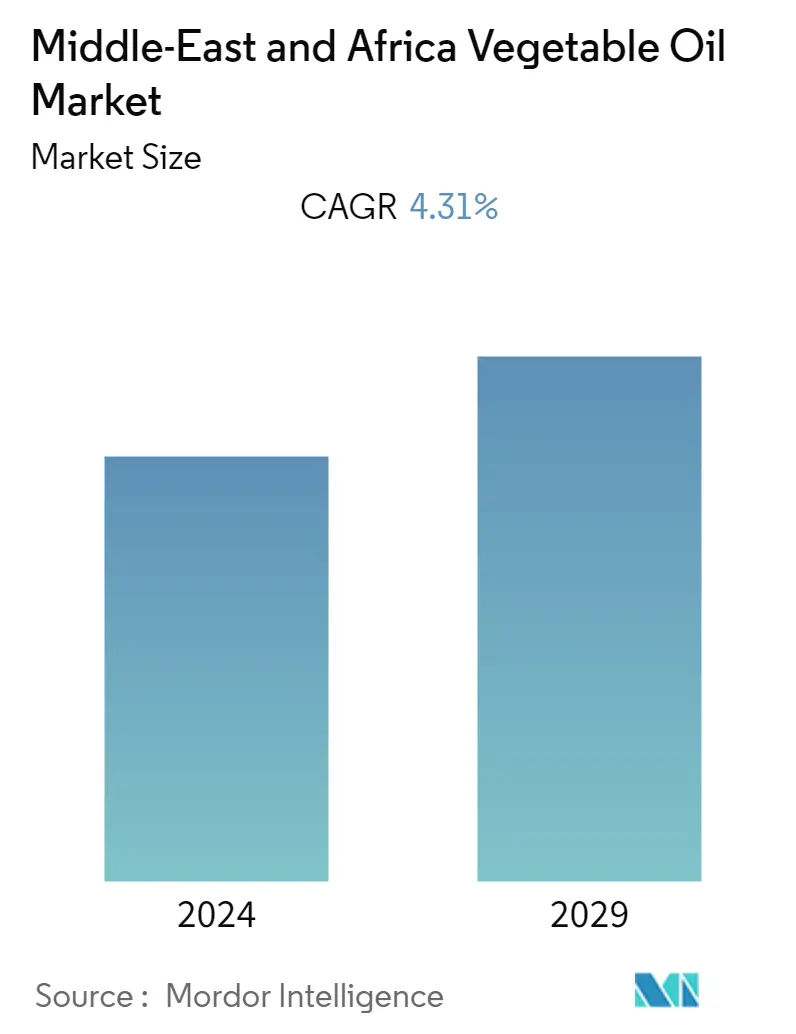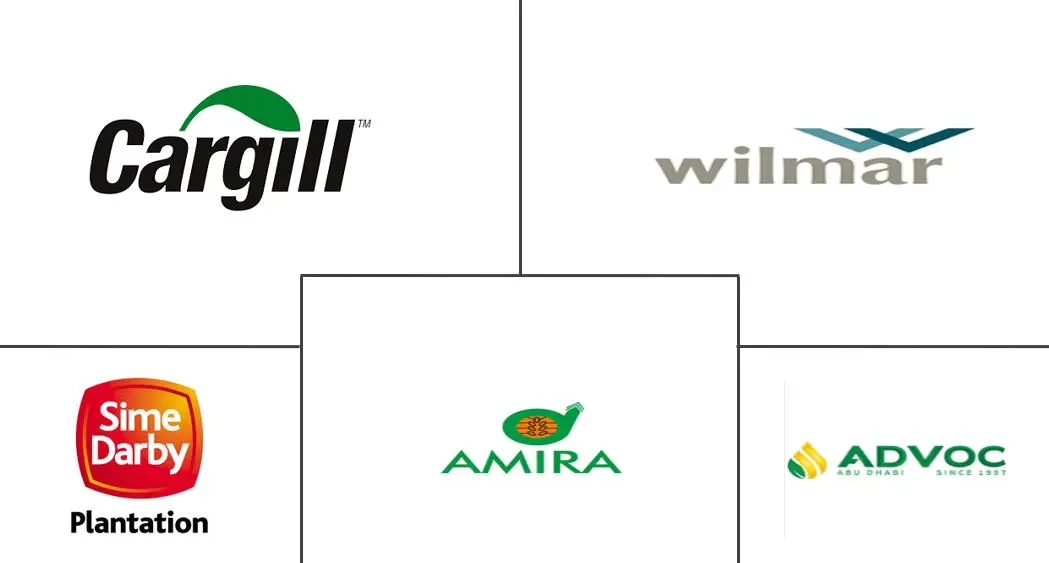Market Size of Middle-East and Africa Vegetable Oil Industry

| Study Period | 2019 - 2029 |
| Base Year For Estimation | 2023 |
| Forecast Data Period | 2024 - 2029 |
| Historical Data Period | 2019 - 2022 |
| CAGR | 4.31 % |
| Market Concentration | Low |
Major Players
*Disclaimer: Major Players sorted in no particular order |
MEA Vegetable Oil Market Analysis
The Middle-East and Africa vegetable oil market is projected to register a CAGR of 4.31% during the forecast period (2022 - 2027).
According to The United States Department of Agriculture report, the growth rate of rapeseed oil consumption in the Middle Eastern country like the United Arab Emirates was stagnant, accounting for 17 thousand metric ton in 2017 and 2018. However, it is projected to grow in the forecast period. The rise in the export of canola oil is witnessed in the regional market. Additionally, due to the import opportunity posed by the ongoing trade war between China and Canada, the United Arab Emirates is projected to augment further the export of canola oil to the Chinese market.
The Middle Eastern region uses vegetable oil, such as sunflower oil, soybean oil, and others, in personal care applications. According to a USDA report, the Middle Eastern region imported 248 thousand metric ton of soybean oil in 2018-2019.
Cargill Incorporate is the leading player operating in the country with its wide range of offerings, including corn oil, rapeseed oil, soybean oil, sunflower oil, and palm oil, among others.
MEA Vegetable Oil Industry Segmentation
The Middle-East and Africa vegetable oil market has been segmented by product type, which includes palm oil, soybean oil, rapeseed oil, sunflower oil, olive oil, and other product types. Based on application, the market is segmented into food, feed, and industrial. The study also involves the regional level analysis of the main countries such as South Africa, the United Arab Emirates, and Rest of Middle-East and Africa. For each segment, the market sizing and forecasts have been done on the basis of value (in USD million).
| By Product Type | |
| Palm Oil | |
| Soybean Oil | |
| Rapeseed Oil | |
| Sunflower Oil | |
| Olive Oil | |
| Other Product Types |
| By Application | |
| Food | |
| Feed | |
| Industrial |
| By Geography | |
| South Africa | |
| United Arab Emirates | |
| Rest of Middle-East and Africa |
Middle-East and Africa Vegetable Oil Market Size Summary
The Middle-East and Africa vegetable oil market is experiencing a steady growth trajectory, driven by diverse applications and strategic trade opportunities. The region's demand for vegetable oils such as sunflower, soybean, and palm oil is influenced by their extensive use in personal care, food processing, and animal feed industries. The United Arab Emirates, in particular, is witnessing a rise in canola oil exports, bolstered by trade dynamics with China. Palm oil remains a significant player due to its high yield per hectare and cost-effectiveness compared to other oils, with Saudi Arabia being a major importer for its food processing units. South Africa stands out as a leading producer of sunflower oil, although it relies on imports for palm oil, highlighting the interconnected nature of the regional market.
The competitive landscape of the Middle-East and Africa vegetable oil market is marked by the presence of major global and local players such as Cargill, Wilmar International, and ADVOC. These companies are focusing on product innovation and strategic expansions to meet evolving consumer preferences and to enhance their market presence. Partnerships and acquisitions, such as Al Ghurair's acquisition of the Edible Oil Company and the joint venture between Archer Daniels Midland Co. and Marathon Petroleum Corp., are indicative of the industry's efforts to scale operations and cater to the increasing demand for renewable diesel fuel. The market's growth is further supported by the strategic collaborations, like the one between Sime Darby Oils and Abu Dhabi Vegetable Oil Company, aimed at strengthening their foothold in the MENA region.
Middle-East and Africa Vegetable Oil Market Size - Table of Contents
-
1. MARKET DYNAMICS
-
1.1 Market Drivers
-
1.2 Market Restraints
-
1.3 Porter's Five Forces Analysis
-
1.3.1 Threat of New Entrants
-
1.3.2 Bargaining Power of Buyers/Consumers
-
1.3.3 Bargaining Power of Suppliers
-
1.3.4 Threat of Substitute Products
-
1.3.5 Intensity of Competitive Rivalry
-
-
-
2. MARKET SEGMENTATION
-
2.1 By Product Type
-
2.1.1 Palm Oil
-
2.1.2 Soybean Oil
-
2.1.3 Rapeseed Oil
-
2.1.4 Sunflower Oil
-
2.1.5 Olive Oil
-
2.1.6 Other Product Types
-
-
2.2 By Application
-
2.2.1 Food
-
2.2.2 Feed
-
2.2.3 Industrial
-
-
2.3 By Geography
-
2.3.1 South Africa
-
2.3.2 United Arab Emirates
-
2.3.3 Rest of Middle-East and Africa
-
-
Middle-East and Africa Vegetable Oil Market Size FAQs
What is the current Middle-East and Africa Vegetable Oil Market size?
The Middle-East and Africa Vegetable Oil Market is projected to register a CAGR of 4.31% during the forecast period (2024-2029)
Who are the key players in Middle-East and Africa Vegetable Oil Market?
Cargill, Incorporated, Sime Darby Plantation Berhad, Wilmar International Limited, Amira Nature Foods Ltd and ADVOC (ABU DHABI VEGETABLE OIL COMPANY) are the major companies operating in the Middle-East and Africa Vegetable Oil Market.

